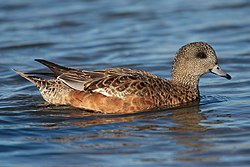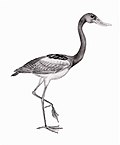| Mareca | |
|---|---|
 | |
| Eurasian wigeon, Mareca penelope | |
| Scientific classification | |
| Kingdom: | Animalia |
| Phylum: | Chordata |
| Class: | Aves |
| Order: | Anseriformes |
| Family: | Anatidae |
| Tribe: | Anatini |
| Genus: | Mareca Stephens, 1824 |
| Type species | |
| Anas penelope Linnaeus, 1758 | |
| Synonyms | |
| |
Mareca is a genus or subgenus of ducks in the family Anatidae that includes the wigeons.
Contents
The species now placed in this genus were formerly placed in the genus Anas . A molecular phylogentic study comparing mitochondrial DNA sequences published in 2009 found that the genus Anas, as then defined, was not monophyletic. [1] Based on the published phylogeny, the genus Anas was split into four monophyletic genera with five extant species moved into the resurrected genus Mareca. [2]
The genus Mareca was introduced by English naturalist James Francis Stephens in 1824. The type species is the Eurasian wigeon. [3] [4] The name of the genus is from the Portuguese word Marreco for a small duck. [5]















